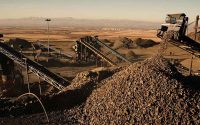Iran plans to stop non-agglomerated iron ore shipments exports in the near term given the need of local steelmakers and the declared aim to increase export of high value-added products. Market insiders, however, are rather skeptical about the success of the move.
Officials at Iran’s Ministry of Industry, Mine and Trade and Iranian Mines and Mining Industries Development and Renovation Organization announced the move to restrict iron ore exports. In case the final decision is taken it will only involve non-agglomerated material.
“Measures will be imposed only on iron ore fines and lumps exports, known as raw iron ore. They won’t be applicable to concentrate and pellets, which are value-added items; they can be exported if local demand is fully covered,” Keyvan Jafari Tehrani, head of international affairs at the Iranian Iron Ore Producers and Exporters Association told Metal Expert – a Ukraine-based provider of news and analysis on steel products and steelmaking raw material industries.
According to the official, the changes are expected to become effective in the beginning of a new Iranian year (March 2017). However, presently there is no clear understanding which measures will be used to restrict the exports – direct ban or export duty, according to IROPEX.
The government plan comes as the domestic steel industry pursues large-scale capacity expansion of raw material processing and crude steel production. To balance the production chain, Iran intends to ramp up pellet capacities from the current 27 million tons to about 63 million tons in 2017.
This is not the first attempt at limiting iron ore exports in order to cover domestic market needs better. In the past Iranian year (ended March 2015) the government announced the initiative to narrow exports of iron ore from the start of the current year.
Self-Adjustment
Last time the market itself adjusted the balance. Export shipments declined significantly when global prices fell making sales in foreign markets unprofitable. But as soon as the situation improved somewhat, overseas supplies revived,” Metal Expert quoted an unidentified market source as saying.
In January-May 2016 Iran’s exports of iron ore dropped 8.5% year-on-year to 5.4 million tons, with almost all the volume sold to China. Even though the government is determined to limit non-agglomerated iron ore exports, it will most likely move in line with market conditions.
“This decision will have no notable impact on China, the major consumer of Iranian iron ore, but it may create opportunities at new outlets, where high value-added products are required,” an unidentified Iranian producer told Metal Expert.
Now pellets are in short supply in the market, but in case Iran manages to implement all its iron ore processing projects and steel consumption does not increase much by the time, local companies may offer pellets in the free market.
“It can happen but under a number of conditions,” the source added.
No export duty is levied on iron ore exports from Iran at the moment, as the 15% tariff for pellets was cancelled at the start of the current Iranian year. Concentrate is being shipped to the foreign markets duty-free.
Source: Financial Tribune





